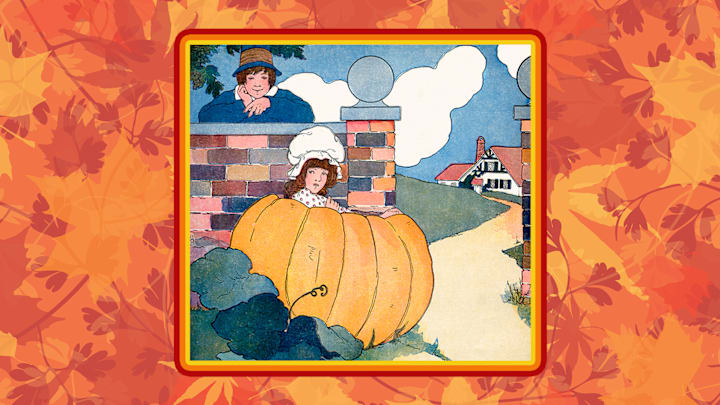Fall is pumpkin season, with patches of the gourds opening up for picking and the smell of pumpkin spice lattes filling coffee shops. Although the orange squash are typically associated with autumn, they have also worked their way into the “Peter, Peter, Pumpkin Eater” nursery rhyme, the lyrics of which usually go like this:
“Peter, Peter, pumpkin eater,
Had a wife but couldn’t keep her;
He put her in a pumpkin shell
And there he kept her very well.
Peter, Peter, pumpkin eater,
Had another and didn’t love her;
Peter learned to read and spell,
And then he loved her very well.”
Here’s a look at the rhyme’s origins, as well as the possible theories behind its meaning—most of which involve murder.
The Pick of the Patch
The presence of pumpkins in “Peter, Peter, Pumpkin Eater” may lead to the assumption that the rhyme has American roots—but its first known appearance in print actually comes from England. According to folklore experts Iona and Peter Opie, the rhyme can be found in Noel Turner’s Infant institutes, part the first. Or, a nurserical essay on the poetry, lyric and allegorical of the earlier ages, which was published in London in 1797. Pumpkins aren’t native to the UK, though they had been introduced back in the 16th century, so the gourd popping up in the song isn’t out of place.
The earliest evidence of the rhyme in the States comes from a collection of Mother Goose stories, published by Munroe & Francis at some point between 1824 and 1827. There’s also a Scottish version—first published in 1868—that contains no pumpkins:
“Peter, my neeper,
Had a wife,
And he couldna’ keep her.
He pat her i’ the wa’,
And lat a’ the mice eat her.”
In Scots, neeper means “neighbor,” wife can be a woman in general, and i’ the wa’ is “in the wall.” Although the wife who couldn’t be kept isn’t necessarily killed in the popular pumpkin version of the rhyme (more on that later), the lesser-known Scottish version makes it clear that Peter murdered a woman by sealing her in a wall and letting mice feast on her.
Yet another alternate—and gourd-less—version of the verse features the lyrics:
“Eeper Weeper, chimney sweeper,
Had a wife and could not keep her;
Had another, did not love her,
Up the chimney he did shove her—
Please turn over my head.”
This version of the tune dates back to at least the early 20th century and sometimes begins “Eaver Weaver.” Iona and Peter Opie report that the tune was sung by children playing a skipping game; if the skipper didn’t miss a jump during the rhyme, further lines were added, such as “How many miles did he shove her? One, two, three, four.” A similar chimney sweeper take on the lyrics was also used as a counting out rhyme, in the same vein as “Eeny, Meeny, Miney, Mo.”
Another Wife Bites the Dust
The kid-friendly explanation of “Peter, Peter, Pumpkin Eater” is that Peter’s wife keeps running away, so he puts her in a carved out pumpkin to keep her in place. However, it’s not hard to see a darker side to the verse.
The most common R-rated theory is that the unnamed wife was cheating on Peter—some say she was a sex worker—which led to him killing her and then hiding her corpse in a huge pumpkin. A less grisly theory is that the “pumpkin shell” is a euphemism for a chastity belt, with Peter locking his wife into the metal underwear to stop her from sleeping around.
The other versions of the rhyme are more explicitly about murder. One theory has it that the version with the wife immured in a wall is actually about the death of Maud de Braose at the start of the 13th century. Maud was the wife of William de Braose, a favorite of King John of England, but the couple fell out of royal favor. When asked to turn one of her sons over to the King, Maud refused on the grounds that he had killed his own nephew. John responded by having both Maud and her son imprisoned in Corfe Castle in 1210.
John apparently decided to be particularly vindictive and had the prisoners sealed in a room with only a sheaf of wheat and a piece of raw meat to eat. Their prison was opened after 11 days and both mother and son had starved to death. Allegedly, Maud even ate her son’s cheeks in an attempt to survive.
The cruel treatment of Maud and her son may even have inspired a section of Magna Carta, with Clause 39 stating that imprisonment or exile shall only be enforced upon someone “by the lawful judgment of his equals or by the law of the land.” But Magna Carta only applied to noble men, so Maud wouldn’t have been covered by the document’s terms even if it had been written before her death.
Read More About Nursery Rhymes:
